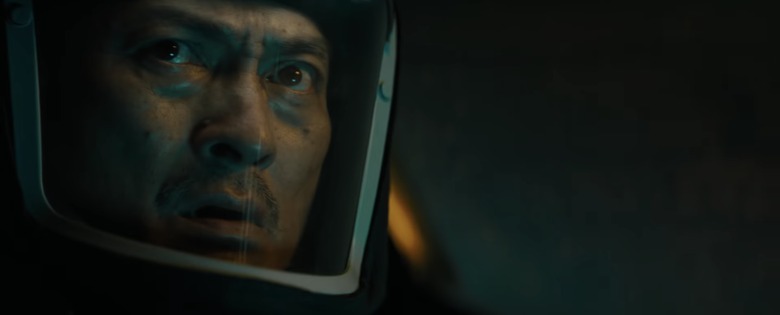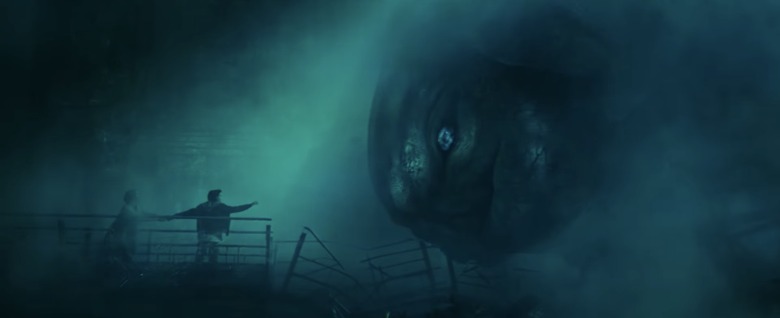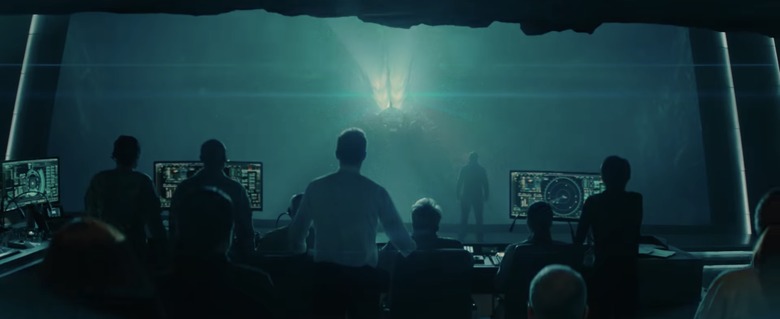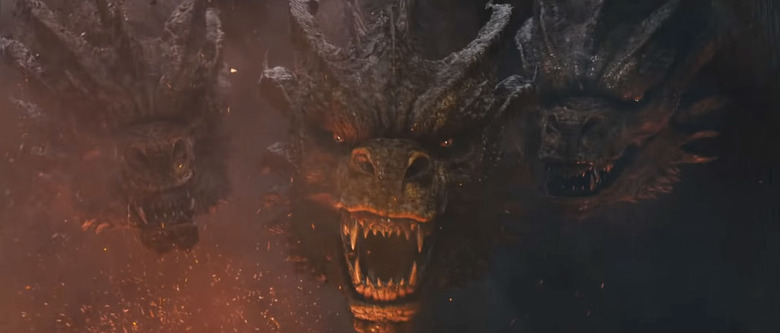'Godzilla: King Of The Monsters' Spoiler Review: A Chip Off The Old Blockbuster
Revealed at Comic-Con last July, the first trailer for Godzilla: King of the Monsters was glorious. The prospect of an elemental assault on the senses, wall-to-wall fights with 17 monsters — maybe even some poignant family drama — seemed to rise up before one's ensorcelled eyeballs with every subsequent trailer.
If Guillermo del Toro's Pacific Rim was the ultimate mechs-versus-monsters movie, then King of the Monsters promised to be the ultimate kaiju-versus-kaiju movie, a gift to Godzilla fans everywhere. Based on some of the early reactions as the movie drew nearer this May, I was expecting to be bludgeoned into submission by a repeating sledgehammer of kaiju action.
There's some of that in the movie, though not as much as you might think. To talk about what works and what doesn't in King of the Monsters, we'll need to open a barrel of radioactive spoilers. Grab your hazmat suit, then, and let's get to it before the earth unleashes a fever to fight "the human infection" and we all perish.
As a film-loving Tokyoite with a natural affinity for Godzilla, I was hoping for something special from King of the Monsters. Coming out of the theater, my initial review of the movie was, "Maa maa."
This is not to be confused with a cry for mother. Quite the contrary, as a cry for mother would imply more feeling, whereas I was trying to communicate a stoic lack of it to my wife, who is Japanese and could therefore understand without me translating that "Maa maa," means, "So-so," or, "Well, well."
Godzilla: King of the Monsters is a maa maa movie, more Justice League than Avengers, on the scale of all-star kaiju gatherings.
I watched the movie twice on opening weekend, purely out of academic interest, and I felt myself growing more charitable to it the second time around. (Repeated exposure: the real secret to liking something.) Any way you slice it, however, King of the Monsters has some issues, many of which plainly originate at the script level.
Keeping Up with the Russells
King of the Monsters is one of those movies where you may be hard-pressed to remember the names of any of the characters unless you cheat and look them up online (which I will shortly demonstrate that I have done). Given that it's a sequel to a Godzilla flick where the title character had roughly eight minutes of screen time, was anyone else surprised by how much of its two-hour length is still devoted to jabbering humans?
Actors like Millie Bobby Brown, Vera Farmiga, and Kyle Chandler do display more immediate charisma than Aaron Taylor-Johnson did in the last movie. (I want to make a clear distinction that "Plain" Aaron Taylor-Johnson is different from Nocturnal Animals Aaron Taylor-Johnson, who is a scene-chewing beast.)
That just means they're facing more of a Bryan Cranston predicament here in that they're always-reliable actors who are saddled with a spotty script. There are indeed many fine actors in this film but unfortunately, some of them, like Zhang Ziyi, are stuck with lines such as, "You're murdering the world!"
Even Farmiga, the self-styled "DJ for the monsters" — whose turntable analyzes and emits bioacoustic patterns — can't quite sell all of her dialogue. Her character, Dr. Emma Russell, is a scientist working for the cryptozoological agency Monarch. She's the one who floats that idea of "the human infection," revealing herself to be in league with a group of ecoterrorists, led by Colonel Alan Jonah (Charles Dance, in full Tywin Lannister mode).
Film reviews, ostensibly of the non-spoiler type, have been bad about revealing this particular plot point, but the movie treats it like a kidnapping at first when Dr. Russell goes off with Jonah's ecoterrorists. Since it was Bring Your Daughter to Work Day at the loosely secured cryptozoological compound, her daughter, Madison, is with her when she unmasks herself as a genocidal madwoman: bent on saving the world by killing it.
Overpopulation, pollution, war ... the checklist of her grievances with humankind sounds reasonable on paper. Dr. Russell talks to Madison about restoring balance a lot, enough to make the Thanos comparisons with her feel justified.
Madison has already gotten dangerously close to one of the monsters, Mothra. She watches in horror as her mother proceeds to summon the walking and flying disasters that will purge the earth of its human infection and allow cities to be overtaken with the spread of wild greenery. These symbolic disaster-monsters are part of the earth's natural defense system, she tells us.
There's a climate change metaphor in there somewhere. For his part, the other Dr. Russell, Emma's ex-husband, Mark, is a real take-charge kind of guy, one of those Gary Sues who is always qualified to speak and who does so as if he were in a perpetual state of simmering anger. It all boils over when he delivers the meme-worthy stand-and-shout of, "You are out of your goddamn mind!"
Now the Nuke Biscuit
Speaking of memes, who remembers the one from the last movie with Ken Watanabe saying, "Let them fight?" It's referenced in King of the Monsters by Bradley Whitford's character.
Keep in mind that Whitford is the same actor who played the father in Jordan Peele's Get Out. This same father threw a house party where there was one random Japanese guest in among two black guests and a bunch of Caucasians.
In King of the Monsters, the only human character who stimulates a hiccup of emotional engagement is Dr. Ishiro Serizawa, played by Watanabe. That's mostly because he's our one-man stand-in for the soul of Godzilla's home country.
In the 2000s, Watanabe emerged as Hollywood's go-to Japanese actor, a role he has continued to fulfill in the MonsterVerse for Legendary Pictures. When Serizawa pilots a sub into the lost city of Atlantis (or some such dead undersea civilization), he's carrying the ball for a whole nation.
Before sacrificing himself for the good of the many, he feeds that ball, or biscuit, to Godzilla. It's like a radioactive doggie treat for the prone monster in his lava lair below the sea. Serizawa pets the monster on the nose—a callback to his insistence earlier that humans would be analogous to Godzilla's pets, not vice versa.
That the biscuit is a nuke and its blast eradicates Serizawa is uncomfortable enough as it is, but in the last movie, we also saw him show a U.S. military commander his father's stopped pocket watch from the Hiroshima bombing.
In another sequel, that might have come back into play more. The movie might have reminded us of its significance with a stray moment of dialogue so that viewers with no memory of a movie pocket watch from five years ago could appreciate how Serizawa's death was bringing him full circle with his family history.
Instead, what we get with Serizawa as he cradles the watch is Mark asking him the time, to which Serizawa responds, "Time to get a new watch." The decision to leave the watch's significance unspoken and internalized with him is understandable from the perspective of creating a quiet character moment but it comes at the expense of lucidity. This movie, as a stand-alone, doesn't clearly express it and so so what you have is essentially a character whose whole arc, as it were, is reduced to an Easter egg.
Blink, and you'll miss the meaning of that watch ... but you won't miss the nuke biscuit. On my second viewing, I caught myself nodding as the setup for this scene began, as if to say, "Ah, here it comes. Now the nuke biscuit."
As the script shuffles Serizawa off with it to meet his death, Whitford's character, the ghost of Get Out, is there. The content Caucasian who will survive this movie says to the Asian who won't, "It's been an honor, man."
Sir, you have no idea. Fortune cookies did likely reach the United States by way of Japanese immigrants but the ones with messages inside are now associated with Chinese restaurants, so when the movie has Serizawa joking about a long message he read in one, it does leave a question mark hanging in the air about whether the screenwriters knew the difference between Chinese and Japanese.
Ghidorah, and Mothra, and Rodan! Oh, My!
In King of the Monsters, the attempts at a climate change metaphor are on the screen, too, not just in the dialogue. The movie does portray its creatures as elemental forces of destruction.
Maybe I just have Game of Thrones on the brain still, but I don't think this film is the first time we've seen three dragon heads beyond a towering ice wall. First known only as Monster Zero, Ghidorah awakens in an Antarctic night blizzard and where he goes, tropical storms soon follow.
Enveloped in smoke, everyone's favorite overgrown Pteranodon, Rodan, comes exploding out of a volcano. Someone blithely describes him as a "fire demon" and his flight over the fictional city of Isla de Mara, Mexico, sends shockwaves rippling over it. This sequence — complete with its ejection-seat landing straight into a monster's mouth — is a highlight, perhaps because it takes place in daylight.
The beautiful, light-giving Mothra spreads her wings out from her cocoon under a raging waterfall. As we've established, Godzilla himself is quite at home in the depths of the ocean, where his air-pocketed lava lair keeps up the elemental motif. We also see monsters burrowing up from the ground in other parts of the world. Earthquakes and make-believe "Category 6" hurricanes signal the arrival of the Titans.
This is a movie of many one perfect shots. Isolated images, frames of the film glimpsed in trailers, evoke the awe-inspiring terror and beauty of a new kind of natural disaster.
Yet with characters we don't care about, the monster fights function as scattered set pieces. It's like hearing a few good guitar chords flitter by in an otherwise fruitless jam session. The songs didn't gel for me the first time around.
In this film, nothing hangs together unless you're using myth as your compass, like Ziyi's knowing character suggests. Only by putting my brain on pause and surrendering to the spectacle as a paramount part of the Godzilla mythos could I enjoy it—which I did, surprisingly, the second time around. Then I felt more like Dorothy in The Wizard of Oz, with Ghidorah, Mothra, and Rodan substituted for lions and tigers and bears.
I may or may not have left the theater with Bear McCreary and Serj Tankien's closing-credits cover of the Blue Oyster Cult song, "Godzilla," stuck in my head. "Go, go, Godzilla," indeed.
If a quippy soldier played by O'Shea Jackson Jr. can stare up at the sky at a rampaging monster and remark, "You've gotta be kidding," the way only a movie character could, then maybe we all need to settle down from running in mass terror at the sight of a harmless, middle-of-the-road blockbuster. Maybe he's got the right idea, guys. Guys?
Seventeen Weightless Monsters
We're not out of the woods yet, Dorothy. Aside from half-formed characters with threadbare personalities like the quippy soldier, King of the Monsters has a few other things working against it.
At times, the creatures have an oddly weightless effect on their surrounding environment. The movie puts us up close with the action but we don't always feel it when it should be shaking our bones.
Humans are kicked around and blown about in vehicles, only to emerge unscathed so they can speak more lines. Missiles knock men aside but they're mostly unhurt, able to brush it off after a quick trip to the recovery bed because they're Gary Sues. The towering ice wall comes crumbling down in massive chunks but not on top of the catwalk or elevator shaft where our heroes are.
Godzilla creates a huge whirlpool in the ocean as he surfaces but when he dives back down, the people perched precariously on top of the submarine next to him only get splashed, like theme park tourists at a killer whale show in SeaWorld. My favorite moment is when Ghidorah flies into the earth's upper atmosphere and drops Godzilla to the ground, but the resulting shockwave stops just short of hurting anyone or even knocking them to their feet.
"There are some things that you can't run from," Dr. Russell says ... but in this movie, explosions are not one of them. Witness, also, Madison conveniently outrunning Ghidorah's energy-beam breath as it cuts through and collapses a building (Fenway Park, I think? It was a little hard to tell through all the smoke.)
It's a cinematic pet peeve of mine when movies or television shows leave themselves open in the background with unneeded characters. I'm not talking about rhubarb-mumbling extras; I'm talking about the kind of narrative slackness that enabled a desert-island show like Lost to bring in two previously unknown characters, Nikki and Paolo, in its third season.
King of the Monsters has a couple of Nikki and Paolo-type creatures. One of them resembles a woolly mammoth. His name is Behemoth. Yes, I had to cheat and Google that because Behemoth is an all-new monster created just for this movie. His sole purpose, besides showing up briefly on control-room monitors and in news footage, is to gather with other monsters at the end and bow before Godzilla.
That was actually my favorite part of the movie, the very end. It's also a fun fake-out right before that when one of Ghidorah's heads comes rising up and you think he's the one who has survived the final fight. Then we see that his head is in Godzilla's mouth and the real King of Monsters is swallowing it.
"Long live the King" ... but whence these Nikki and Paolo-type creatures? Telling us that there are 17 kaiju wreaking havoc across the earth at the same time is a curious storytelling decision.
Why that specific number, 17? Are we really to believe there are 17 Hurricane Ghidorahs devastating major population centers all at once? Why not just keep it tight and limit the number to four famous monsters, plus two or three others to keep around for the end when everyone is bowing before Godzilla?
This movie is really about Godzilla, Ghidorah, Mothra, and Rodan. That's all we needed. It would have been more than enough to stop with the re-awakenings after Rodan. You could have had Godzilla and Mothra team up against Ghidorah and Rodan and that still would have been worth the price of admission.
As it is, the film leaves too many monster heads unaccounted for and it has too many human heads talking and joking and confusing us with the faces of their identical twins. Ziyi plays two different characters at two different locations on Earth in this movie, but you could be forgiven for not catching that.
Don’t Be Afraid. Be a (Franchise) Friend?
Honest question: when has a Godzilla movie ever been memorable for its richly drawn human characters? When has it ever needed an overabundance of failed comic relief (besides the ironic humor that comes with campy kaiju flicks)?
It might actually be interesting to see one of these giant monster movies backdropped against a well-written, character-based human drama, but that's not the story we get with the Russell family or even Serizawa. Maybe we're holding this film to an unrealistic standard because it's a blockbuster and not a B-movie.
There's cheesy good fun to be had all throughout the Godzilla franchise. While I wouldn't presume to know after one weekend how this entry will be regarded in the years to come, I think it's worth considering, by way of a final analysis here, how King of the Monsters measures up to the legacy that came before it.
The crushing weight of expectations can be a death sentence for any movie. If it sounds like I'm being hard on King of the Monsters in this review, then I must stress that this criticism comes from a place of tough love.
Godzilla movie number 35 is part of a tradition that I love. I appreciate how the film respects the 65-year canon of Toho's creature features, which together comprise the longest running film franchise in history.
I do believe that liking or disliking a movie can sometimes be a decision more than an honest feeling, among both critics and fans. Maybe some voices swim in for the kill only after they see blood in the water and it's agreed-upon among their peer group that the sharks are going to attack this thing, be it the movie itself or an online reviewer.
People pounce on a swimming kaiju to show off their critical acumen and fans rise up to defend it like a school of protective piranha. It becomes this feedback loop — a wheel, if you will — of harsh opinions.
As much as I'd love to vociferate, "I will break the wheel," like some would-be new Father of Dragons (Game of Thrones, y'all, still not over it), I'm just one guy sipping orange juice in a cafe with a life-size Godzilla head outside of it. No, seriously.
The weekend before King of the Monsters had its same-day release in the U.S. and Japan, Roland Emmerich's Independence Day played as the Saturday night movie on Fuji TV—one of the major Japanese TV stations.
Matt Singer over at ScreenCrush compared King of the Monsters to Independence Day: Resurgence. I never bothered to see Resurgence, but there were times during the initially hollow spectacle of King of the Monsters that I did almost feel like I was watching a globe-hopping Emmerich disaster flick disguised as a Godzilla film.
We've already seen Emmerich's take on Godzilla and it's easily dismissible, but after watching King of the Monsters, I came away with a renewed appreciation for the thematic aim of the 2014 Gareth Edwards Godzilla (or as I like to think of it, "Quicksilver and Scarlet Witch vs. the MUTOs vs. Godzilla.")
That wasn't a great movie, mind you. Godzilla didn't even show up until the 59-minute mark and even then it cutely cut away to a kid watching him fight on television, thinking he was seeing dinosaurs on the news.
The movie did, however, show reverence to Godzilla's roots as a nuclear metaphor. Both it and Hideaki Anno's 2016 Japanese rebuttal, Shin Godzilla, were supercharged by the 2011 Tohoku earthquake and tsunami and the ensuing Fukushima Daichi nuclear disaster. These events left a legacy of potent real-world trauma on the movies, not unlike the atomic bombings of Hiroshima and Nagasaki left on Ishiro Honda's original 1954 Godzilla film.
Just last year, Netflix's Dark Tourist showed a bus load of foreign schmucks venturing into an irradiated zone in Fukushima with Geiger counters. Shades of Cranston and Taylor-Johnson wandering around the fictional Japanese ghost town of Janjira.
King of the Monsters seemed poised to meaningfully revisit the next chapter of Godzilla's history, whereby he went from being a symbol of the mushroom cloud to engaging in dust-ups with other monsters. The movie flirts with climate change metaphors but it's diffusion of disasters doesn't quite congeal into a compelling enough whole.
I wanted to like it, and I didn't hate it, but I didn't love it, either. To me, it's most interesting as a franchise artifact.
We'll have another article up this week exploring the film's many kaiju-literate references, but in the meantime, I can only cycle back to my first impression and say that Godzilla: King of the Monsters mostly fell flat for me as a piece of surface-level entertainment. Considered apart from the pull of its franchise and shared-universe mythology, I just had zero investment in most of what was happening up on screen until the obligatory end credits scene. Which makes it not so different from any other run-of-the-mill 2010s blockbuster.




